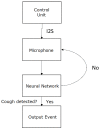Non-Contact Thermal and Acoustic Sensors with Embedded Artificial Intelligence for Point-of-Care Diagnostics
- PMID: 38202998
- PMCID: PMC10781379
- DOI: 10.3390/s24010129
Non-Contact Thermal and Acoustic Sensors with Embedded Artificial Intelligence for Point-of-Care Diagnostics
Abstract
This work involves exploring non-invasive sensor technologies for data collection and preprocessing, specifically focusing on novel thermal calibration methods and assessing low-cost infrared radiation sensors for facial temperature analysis. Additionally, it investigates innovative approaches to analyzing acoustic signals for quantifying coughing episodes. The research integrates diverse data capture technologies to analyze them collectively, considering their temporal evolution and physical attributes, aiming to extract statistically significant relationships among various variables for valuable insights. The study delineates two distinct aspects: cough detection employing a microphone and a neural network, and thermal sensors employing a calibration curve to refine their output values, reducing errors within a specified temperature range. Regarding control units, the initial implementation with an ESP32 transitioned to a Raspberry Pi model 3B+ due to neural network integration issues. A comprehensive testing is conducted for both fever and cough detection, ensuring robustness and accuracy in each scenario. The subsequent work involves practical experimentation and interoperability tests, validating the proof of concept for each system component. Furthermore, this work assesses the technical specifications of the prototype developed in the preceding tasks. Real-time testing is performed for each symptom to evaluate the system's effectiveness. This research contributes to the advancement of non-invasive sensor technologies, with implications for healthcare applications such as remote health monitoring and early disease detection.
Keywords: acoustic; low-cost hardware; neural networks; remote; sensors; thermal.
Conflict of interest statement
Authors Sara Díez-del-Valle Garzón and Roberto García-García were employed by the company Ambar Telecomunicaciones S.L. and Centro de Innovación de Servicios Gestionados Avanzados (CiSGA) S.L. The remaining authors declare that the research was conducted in the absence of any commercial or financial relationships that could be construed as a potential conflict of interest.
Figures










Similar articles
-
Advancing glaucoma detection with convolutional neural networks: a paradigm shift in ophthalmology.Rom J Ophthalmol. 2023 Jul-Sep;67(3):222-237. doi: 10.22336/rjo.2023.39. Rom J Ophthalmol. 2023. PMID: 37876506 Free PMC article. Review.
-
Recording human electrocorticographic (ECoG) signals for neuroscientific research and real-time functional cortical mapping.J Vis Exp. 2012 Jun 26;(64):3993. doi: 10.3791/3993. J Vis Exp. 2012. PMID: 22782131 Free PMC article.
-
Acoustic Emission and Artificial Intelligence Procedure for Crack Source Localization.Sensors (Basel). 2023 Jan 7;23(2):693. doi: 10.3390/s23020693. Sensors (Basel). 2023. PMID: 36679490 Free PMC article.
-
Speakers-Used as sensors for detecting acoustic loads with artificial intelligence.J Acoust Soc Am. 2024 Aug 1;156(2):1319-1323. doi: 10.1121/10.0028298. J Acoust Soc Am. 2024. PMID: 39177363
-
A Review of Emerging Electromagnetic-Acoustic Sensing Techniques for Healthcare Monitoring.IEEE Trans Biomed Circuits Syst. 2022 Dec;16(6):1075-1094. doi: 10.1109/TBCAS.2022.3226290. Epub 2023 Feb 14. IEEE Trans Biomed Circuits Syst. 2022. PMID: 36459601 Review.
References
MeSH terms
Grants and funding
LinkOut - more resources
Full Text Sources
Research Materials
Miscellaneous

